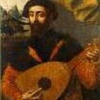
Francesco Bartolomeo Conti Sheet Music
- Born: 20th January 1681
- Died: July 1732
- Birthplace: Florence, Italy
Francesco Bartolomeo Conti was an Italian composer and player of the mandolin and theorbo. He also wrote the oldest mandolin method book that has survived. Little is known about the biography of Conti. He was born in Florence, Italy. By 1700 he was already known as a theorbist not only in his native Florence, but also in other cities such as Ferrara and Milan. The fame he enjoyed by 1701 enabled him to obtain appointment as an auxiliary theorbist at the Habsburg court in Vienna with the same salary as the main theorbist, Orazio Clementi. At the 1706 carnival he made his debut as an opera composer with Cleotide, and in 1713 was appointed as a court composer. In 1708, with the death of Clementi, Conti was promoted senior theorbist, a position he held until 1726. In the same year he was elected a member of the Accademia Filarmonica of Bolognaand in 1711 he was appointed vice-Kapellmeister (vice-maestro di cappella) in Vienna. In April of that year, after the death of his first wife, Theresia Kugler, Conti remarried to prima donna Maria Landini, at that time the highest-paid singer in Vienna. She sang the main soprano roles in Conti's operas from 1714 and 1721, but died in 1722. After her death Anna Maria Lorenzana was appointed prima donna and performed in three more of Conti's operas. She became his third wife in April 1725. On 28 August 1723, Conti, as theorbist, took part in the first performance of the festival opera Costanza e Fortezza by Johann Joseph Fux. In 1726 and again during 1729 to 1732 Conti visited Italy because of health problems. He returned to Vienna in 1732, where he staged two new operas but in July of the same year he died. He was succeeded by his son Ignazio Conti (Florence 1699-1759). Although Il mio bel foco (Quella fiamma) has long been attributed to Venetian composer and statesman Benedetto Marcello (1686-1739), recent scholarship now identifies the Florentine Francesco Bartolomeo Conti (1681?-1732) as the likely composer of this lovely song. Conti was also a supreme player of the mandolin, and wrote the earliest sonatas for the instrument. His works composed between 1714 and 1725 were primarily written for the carnival season or to celebrate birthdays and name days of the members of the Imperial family. Handel reused some of Conti's music for Cleotide in his pasticcio Ormisda (1730) performed at the Queen's Theatre. His music was also appreciated by Johann Sebastian Bach, and Conti's cantata Languet anima mea, survives in a manuscript version from 1716 as arranged by Bach (BWV deest 1006).